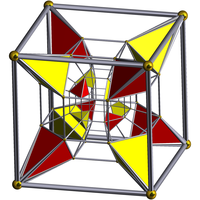Small disprismatotesseractihexadecachoron
| Small disprismatotesseracti-hexadecachoron | |
|---|---|
 | |
| Rank | 4 |
| Type | Uniform |
| Notation | |
| Bowers style acronym | Sidpith |
| Coxeter diagram | x4o3o3x ( |
| Elements | |
| Cells | 16 tetrahedra, 32 triangular prisms, 8+24 cubes |
| Faces | 64 triangles, 48+96 squares |
| Edges | 96+96 |
| Vertices | 64 |
| Vertex figure | Triangular antipodium, edge lengths 1 (small base), and √2 (large base and sides)  |
| Measures (edge length 1) | |
| Circumradius | |
| Hypervolume | |
| Dichoral angles | Tet–3–trip: 150° |
| Cube–4–trip: | |
| Cube–4–cube: 135° | |
| Central density | 1 |
| Number of external pieces | 80 |
| Level of complexity | 8 |
| Related polytopes | |
| Army | Sidpith |
| Regiment | Sidpith |
| Dual | Triangular-antitegmatic hexacontatetrachoron |
| Conjugate | Quasidisprismatotesseracti-hexadecachoron |
| Abstract & topological properties | |
| Flag count | 3072 |
| Euler characteristic | 0 |
| Orientable | Yes |
| Properties | |
| Symmetry | B4, order 384 |
| Convex | Yes |
| Nature | Tame |
The small disprismatotesseractihexadecachoron, square duoexpandoprism, or sidpith, also commonly called the runcinated tesseract, is a convex uniform polychoron that consists of 16 regular tetrahedra, 32 triangular prisms, and 8+24 cubes. 1 tetrahedron, 3 triangular prisms, and 1+3 cubes join at each vertex. It is the result of expanding the cells of either a tesseract or a hexadecachoron outwards, and thus could also be called the runcinated 16-cell.
It is the third in the series of duoexpandoprisms formed as the convex hull of a compound of two perpendicular square-octagonal duoprisms and the only uniform one. Blending it with these duoprisms produces the inverted quasiprismatodishexadecachoron. It additionally contains the vertices and edges of the small rhombicuboctahedral prism.
Gallery[edit | edit source]
-
B4 Coxeter plane projection
-
Wireframe
-
Net
-
Cross-section animation
Vertex coordinates[edit | edit source]
Coordinates for the vertices of a small disprismatotesseractihexadecachoron with edge length 1 are given by all permutations of:
- .
Representations[edit | edit source]
A small disprismatotesseractihexadecachoron has the following Coxeter diagrams:
- x4o3o3x (






 ) (full symmetry)
) (full symmetry) - xxxx4oooo3oxxo&#xt (B3 axial, cube-first)
- xxxowoqo3ooqooqoo3oqowoxxx&#xt (A3 axial, tetrahedron-first)
- xowqwox xxxxxxx4oxoxoxo&#xt (B2×A1 symmetry, cube-first)
- qo3oo3oq *b3xx&#zx (D4 symmetry)
- wx xx4oo3ox&#zx (B3×A1 symmetry)
- xo4xx ox4xx&#zx (B3×B2 symmetry, square duoexpandoprism)
- wxxx xwxx xxwx xxxw&#zx (K4 symmetry)
Semi-uniform variant[edit | edit source]
The small disprismatotesseractihexadecachoron has a semi-uniform variant of the form x4o3o3y that maintains its full symmetry. This variant uses 8 cubes of size x, 16 tetrahedra of size y, 32 semi-uniform triangular prisms of form x y3o, and 24 semi-uniform square prisms of form y x4o as cells, with 2 edge lengths.
With edges of length a (of cubes) and b (of tetrahedra), its circumradius is given by and its hypervolume is given by .
It has coordinates given by all permutations of:
- .
Variations[edit | edit source]
The uniform small disprismatotesseractihexadecachoron, and indeed the semi-uniform variants, are a special class of the general isogonal square duoexpandoprism. This general variant has as cells 2 sets of 8 square prisms, 16 rectangular trapezoprisms, 32 wedges, and 16 tetragonal disphenoids as cells. They can generally be obtained as the convex hull of 2 orthogonal square-ditetragonal duoprisms.
This is one of a total of five polychora that can be obtained as the convex hull of two orthogonal square-ditetragonal duoprisms. To produce variants of this polychoron, if the polychoron is written as ao4bc oa4cb&#zy, c must be in the range . It generally has circumradius .
Related polychora[edit | edit source]
The small disprismatotesseractihexadecachoron is the colonel of a regiment with a total of 8 uniform and 6 scaliform members. Of these members, 7 have full tesseractic symmetry, namely sidpith, stefacoth, shafipto, steth, dippit, snappoth, and snipto. The eighth uniform member iquipadah and the 6 scaliform members have square duoprism symmetry. The compound octagonal diorthoprism can be edge-inscribed in this polychoron.
A small disprismatotesseractihexadecachoron can be constructed from a small rhombicuboctahedral prism by attaching cube atop small rhombicuboctahedron segmentochora to its bases. The cap from the set of 24 cubes is the square cupofastegium.
Uniform polychoron compounds composed of small disprismatotesseractihexadecachora include:
- Small prismated great icositetrachoron (3)
- Small prismated great stellated tetracontoctachoron (6)
- Small prismated dodecahedronary cubichoron (75)
External links[edit | edit source]
- Bowers, Jonathan. "Category 11: Antipodiumverts" (#447).
- Bowers, Jonathan. "Tessic Isogonals".
- Klitzing, Richard. "sidpith".
- Quickfur. "The Runcinated Tesseract".
- Wikipedia contributors. "Runcinated tesseract".



























